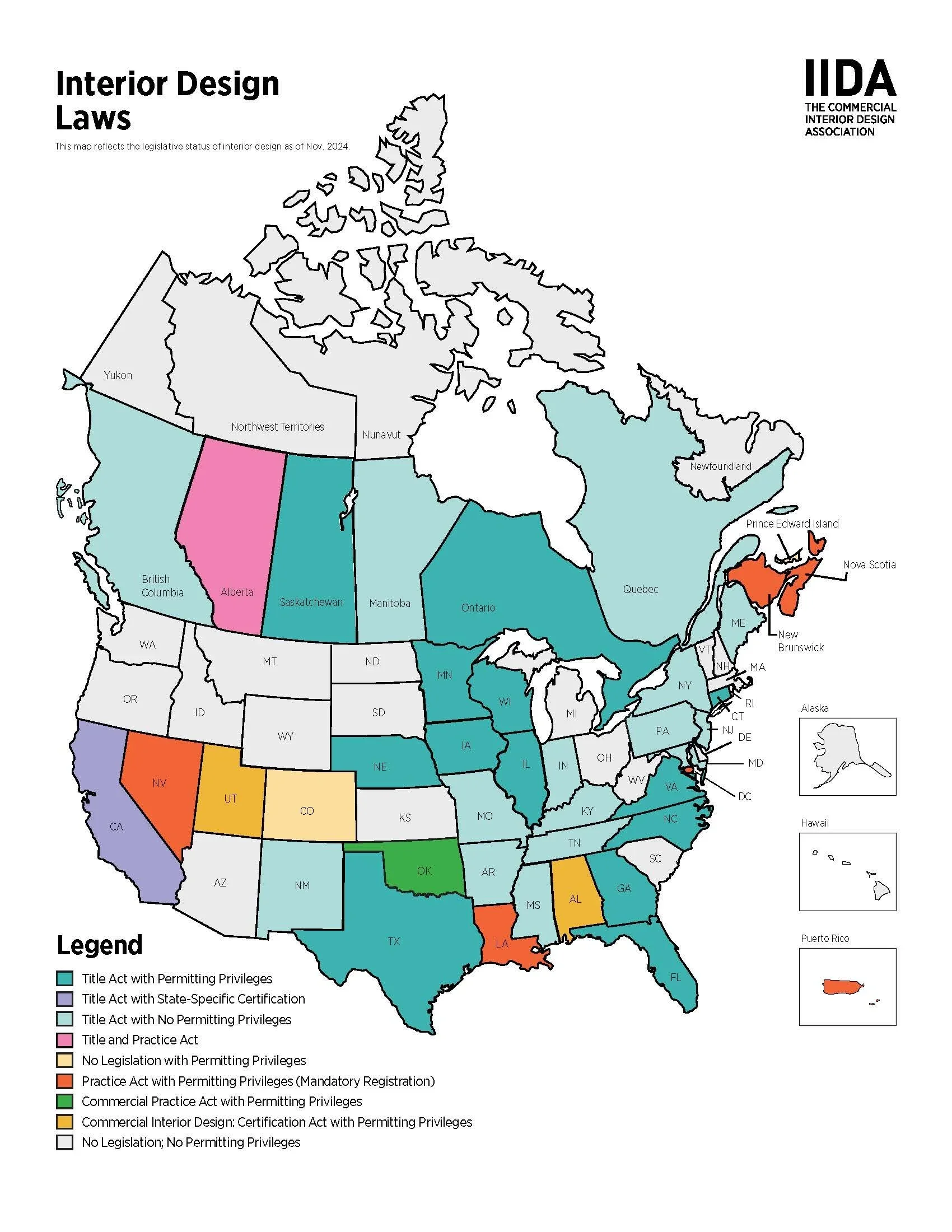IIDA Mid-America actively advocates for state-level recognition and legislation that elevates the profession, defines our responsibilities, and ensures interior designers have a strong, consistent voice in shaping the built environment.
ADVOCACY
IIDA ADVOCACY MISSION
State-level regulations for interior design are essential to setting and upholding professional standards that protect the health, safety, and welfare of the public.
IIDA believes that legal recognition through registration or certification creates consistency across the profession, clarifies the responsibilities of interior designers, and strengthens a culture of excellence in our industry.
Interior Design
Interior design encompasses the analysis, planning, design, documentation and management of interior non-structural/non-seismic construction and alteration projects in compliance with applicable building design and construction, fire, life-safety and energy codes, standards, regulations and guidelines for the purpose of obtaining a building permit as allowed by law.
Qualified by means of education, experience and examination, interior designer have a moral and ethical responsibility to protect consumers and occupants through the design of code compliant, accessible and inclusive interior environments that address well-being, while considering the complex physical, mental and emotional needs of people.
Why Registration Is Important
The goal of IIDA’s advocacy efforts is to ensure that Commercial Interior Designers can practice to their fullest abilities through robust interior design legislation. Interior Design legislation helps establish and maintain professional standards that protect the health, safety and welfare of the general public.
IIDA firmly believes that legal recognition, achieved through licensing, registration, and certification, brings uniformity to the profession, defines responsibility, and encourages excellence in the Interior Design industry.
Currently there are 125 Registered Interior Designers in Missouri.
To get registered, please follow the link.
Resources
IIDA has developed talking points, guides, and resources including sample information used by IIDA Chapters nationwide, to assist students, educators, and design professionals in successfully becoming Interior Design advocates.
Click the buttons below to learn more about advocacy.
Link to Missouri registration – Tips/Tricks/Links to school transcripts.
-
To advocate for interior design means to support, champion, and commend the profession to people, organizations, and legislators. It also means knowing how to communicate what interior designers do to various stakeholders. Public perception influences your practice in many ways, including your legal standing as a professional at both the state and national levels, access to resources, salaries, and the way you are treated by clients and colleagues alike.
-
Interior designers follow life-safety, fire, and building codes, and American with Disabilities Act (ADA) specifications, as well as best practices for wellness, sustainability and green building practices, and ergonomics. Professionals maintaining current interior design certification are knowledgeable of new codes, initiatives, and key design strategies and act as advocates for the general public and their own communities. They also have the opportunity to mentor students and younger design professionals on the realities of the practice and create a dialogue of issues relevant to the industry.
-
The NCIDQ exam, follow the link to confirm eligibility requirements and apply.
-
After a state legislature passes a law that creates a titles of “registered interior designer” (RID), only those who have submitted the necessary education, experience, and examination to the state can call themselves a “RID”. Sometimes these laws also allow RIDs to stamp and seal drawings for permits and/or bid on state projects. In some states, registration is used interchangeably with certification.
Registration ensures public protection because it shows consumers and clients that we have met the minimum standards to call ourselves a RID. Clients can be assured we have the education, examination, and experience necessary to be a professional interior designer. Additionally, registration laws give consumers a venue for the redress of grievances and complaints against RIDs.
Numbers don’t lie. If we want to enhance our state’s interior design legislation, high numbers of RIDs show legislators that registration matters to the profession. Registration shows that interior designers are professionals on par with architects, landscape architects, and engineers for their specific are of expertise.
-
There are three types of interior design:
Title Act: Protects a certain title such as “Registered Interior Designer” or “Certified interior Designer” but does not define interior design practice and does not allow for stamp and seal privileges of interior construction documents.
Practice Act: Legally defines the scope and practice of RIDs or CIDs, protects a certain title such as RID or CID, outlines registration requirements for interior designers, and establishes penalties for violations.
Stamp & Seal Privileges: In conjunction with a Practice Act, this allows RIDs the additional ability to sign and seal commercial, code-impacted work in order to be submitted for a construction permit. This type of legislation allows RIDs to perform commercial work independently of an architect, if they so choose, and obtain permits for their own work.
-
-
The ability to stamp & seal drawings within a defined scope and for the acceptance of that stamp to be codified in state law to ensure consistent acceptance at building departments throughout Missouri.
-
-
Text “Interior Design” to 52886 and follow the message prompts to receive updates at the local, state, and national level.



